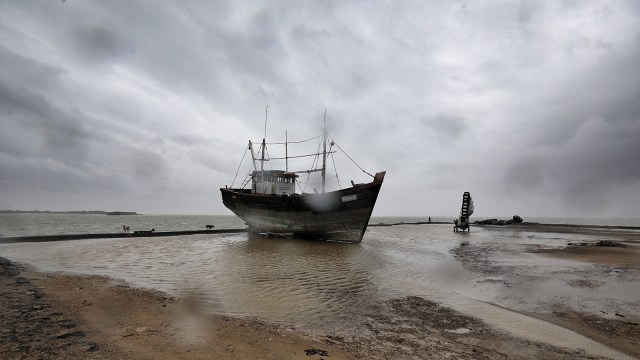In a first, INCOIS study quantifies dominant factors contributing to cyclone genesis, intensification
The study by the Hyderabad-based Indian National Centre for Ocean Information and Services aimed to address the difficulty in tracking a cyclone’s rapid intensification as it rages on.
 The Indian coasts face threats from cyclones during the April-May and October-December periods, with May and November seeing the most intense storms. (Express Archive)
The Indian coasts face threats from cyclones during the April-May and October-December periods, with May and November seeing the most intense storms. (Express Archive)For the first time, scientists from the Indian National Centre for Ocean Information and Services (INCOIS) have quantified the oceanic and atmospheric factors that contribute to both cyclone formation and its intensification. This information, they said, could prove handy in improving predictions of cyclones and their intensities, ultimately helping to plan for contingencies and evacuation.
The Indian coasts face threats from cyclones during the April-May and October-December periods, with May and November seeing the most intense storms. While three out of the four cyclones that develop in a calendar year develop in the Bay of Bengal, there have been intense storms emerging in the Arabian Sea in recent years. In addition, these storms are showing a tendency for rapid intensification while at sea, making cyclone intensity prediction a challenge.
The study conducted by the Hyderabad-based institute under the Ministry of Earth Sciences aimed to address this difficulty in tracking the rapid intensification as the cyclone rages on. Senior scientist R Harikumar, along with PhD scholar G G Zahid, studied Cyclone Tauktae as a case study and compared it with three other cyclones Ockhi, Amphan, and Mocha.
Cyclone Tauktae, which developed in the Arabian Sea in May 2021, intensified into a cyclone of ‘extremely severe’ category (wind speed 160 – 220 kmph) and went on to become the deadliest storm to develop over the Arabian Sea during 2012-2023. In its course, Tauktae toppled Barge P305, an ONGC vessel over the Bombay High oil field, killing dozens of people. Cyclone Tauktae reached as close as 140 km to India’s west coast before it made landfall over south Gujarat.
There are numerous atmospheric and oceanic contributory factors at play in the cyclone’s development and intensification. In some cases, a dominant role is played by either ocean or atmosphere.
“But in case of Cyclone Tauktae, it was found that the atmosphere’s role was marginally more (about 54 per cent) compared to the ocean’s role (about 46 per cent) towards the storm’s intensification. This is for the first time that we have been able to quantify the contributions made by oceanic and atmospheric factors,” Harikumar told The Indian Express.
The duo developed a novel methodology, and in their study published in Nature’s Scientific Reports, suggested factors that must be considered at the time of predicting the development of cyclones – namely mid-atmospheric humidity, low-level absolute vorticity, vertical wind shear and the tropical cyclone heat potential. According to their observations, in the days leading to the development of Cyclone Tauktae, the humidity levels, the ocean heat potential, moisture and the land mass temperatures were all higher than normal, a clear sign of the impending cyclone intensity of Tauktae.
The INCOIS researchers compared their method by validating the same with cyclones Ockhi, Amphan and Mocha, each of them unique for either track or intensity. They found that in case of Cyclone Ockhi, oceanic factors dominated at 73 per cent and in the case of Super Cyclone Amphan, it was at 57 per cent. Atmospheric factor (54 per cent) dominated in the case of Cyclone Mocha.
Harikumar’s team is presently developing a tool that will collate all this information so that organisations like the India Meteorological Department (IMD) can incorporate it into their forecast regimes. This method, the researchers said, can be applied across ocean basins in the world.







